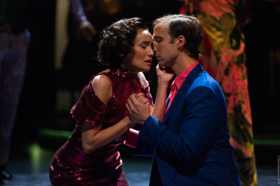Review: In Any Language, the London-Thoron HATUEY Brings Fire to Kasser Theatre at Montclair State

Patrick Morris. Photo: Maria Baranova
"A Ukrainian Jew walked into a bar in Havana..." Wait, haven't I heard this one before? Not by a longshot. HATUEY: MEMORY OF FIRE, the opera by Frank London and Elise Thoron, performed in Yiddish, English and Spanish, is a unique work that ambitiously crosses many creative lines in a work inspired by a 126-page Yiddish epic poem.
Montclair State's Peak Performances series at the Kasser Theatre presented the US premiere of the work, over the last two weekends; it was performed in Havana last year in a different form (and all in Spanish). (Performances remain on Saturday evening, the 22 at 8 pm and Sunday the 23 at 3 pm.)
It was composed by London, one of the founder of the Klezmatics--the American klezmer music group based in New York City, whose music mixes older Yiddish tunes with other types of more contemporary music (here, with a little help here from Irving Berlin, whose "I'm Flying Down to C-U-B-A" is included in a nightclub number).
He employed a variety of styles that raised the musical temperature onstage to a boil. He knows how to mix many styles and come up with a cohesive score--and called on many of his resources here to bring this multi-faceted story to life, under the baton of Music Director Constantine Kitsopoulos and the exciting performance of the stage band.

Photo: Maria Baranova
Three different stories unfold in Thoron's libretto, drawing parallels between the persecution of the Jews in the early 20th century and the attempt by Conquistadors from Spain to wipe out the Indian culture of the Tainos in Cuba 400 years earlier.
While the result was often compelling, I thought that in a number of places the words and music could have been better integrated. Too many key elements of the story were told--Thoron is as playwright--rather than sung and some characters were badly in need of fleshing out. I admired, however, the seamless way the story moved among the languages, particularly the sections of Penn's epic that are sung in Yiddish.
The cast, many with opera backgrounds that facilitated the shifts between the different languages being used, was splendid in pulling the piece together musically. Standouts included Jennifer Jade Ledesna as Tinima, the nightclub singer, with an earthy quality and vibrant voice, and Matthew Patrick Morris as Oscar (modeled after Asher Penn), with his appealingly sweet, light tenor.
A notable contribution came from baritone Nathaniel Stampley, who had stage presence to spare and an easy but resonant singing style. Another key performance came from soprano Nicolette Mavroleon, as Kasike, the tribal leader, who sang intensely and was a riveting to watch.

Photo: Maria Baranova
Cleanly and urgently directed by Mary Birnbaum and choreographed by Maija Garcia, the action shifts among a Havana nightclub in 1931, where a fictionalized version of the epic's author, Asher Penn, is introduced to the story of the chieftain, Hatuey, and becomes involved in an uprising against the Cuban dictator; Cuba in 1511, where the Spanish, in search of gold, attempt to annihilate the Siboney Indians and Taino culture; and the Ukraine in the 1910s, where the persecution of the Jews was so common that the US limited the number of immigrants (Jews and others), thus sending Penn to Havana instead.
The work was well-designed by Camellia Koo to keep the action moving, with moody lighting by Devorah Kengmana. Especially fine were the costumes by Oana Botez that included headdresses designed by Jorge Estevez, part of a project team at the National Museum of the American Indian in New York and a Taíno from the Dominican Republic (whose pre-performance talk added some information that clarified several points only glossed over in the piece).
At a time when many kinds of musical theatre pieces are called "opera"--perhaps to lend some gravitas to the effort and content--I'm not sure that this one falls easily under the rubric. Whatever you call it, however, it provided some pointed insights into cultures and history that have previously been bypassed, in a lively performance.
Reader Reviews

Videos

